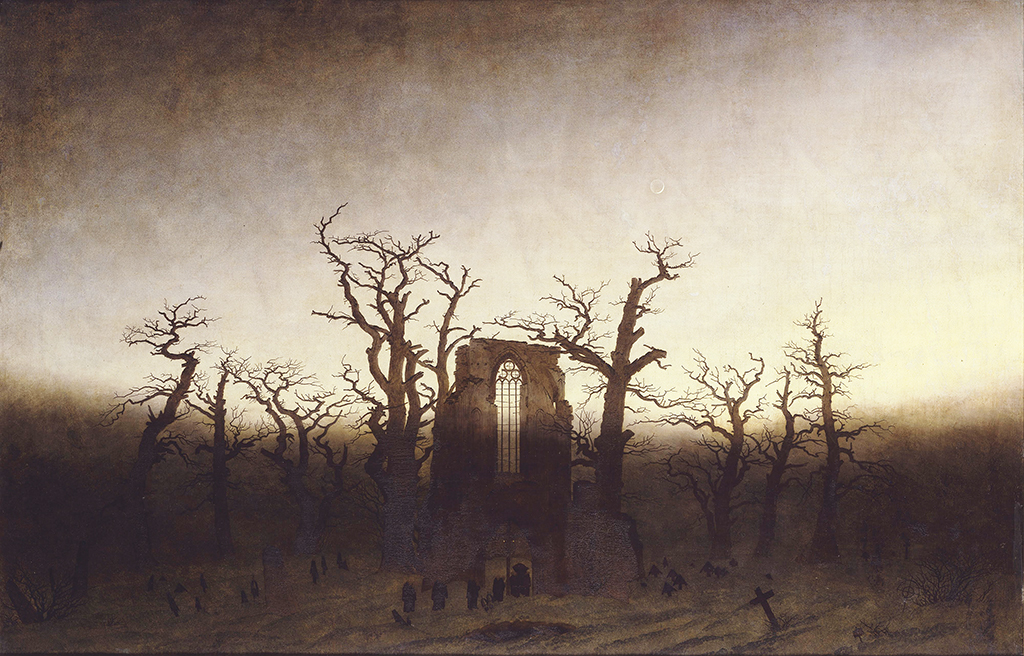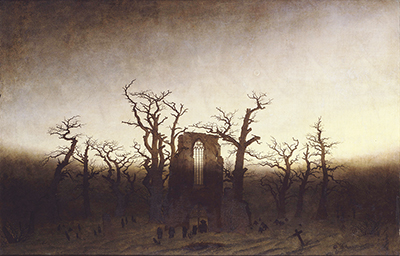The Abbey in the Oakwood, Abtei im Eichwald, was painted by Caspar David Friedrich between the years of 1809 and 1810, which was a particularly prolific and successful period in this German Romanticist painter's career.
The artist placed this work into an exhibition in Dresden and managed to sell all of his contributions to this show. It marked an important step in him gaining true acceptance as an artist. The content found in this painting is highly typical of Friedrich, boasting dark tones across a relatively plain landscape. His use of cemeteries and graves can also be found in many other paintings produced by this artist. He managed to achieve an eerie atmosphere within his work that would later inspire many other significant European artists.
It requires a close inspection of the painting in order to make out a number of figures in the foreground as they are both small but also their tones are similar to the environment in which they wander. These figures are carrying a coffin into the abbey which the artist uses to represent the passage of time, passing as it does in this scenario. The dark tones, which may remind some of Whistler, help to create an atmosphere of tension and sadness, which the artist did so in many other paintings too. The abbey itself is also in disrepair, now consisting of just a few remaining parts, with the main construction lost to the elements. As humanity struggles, nature takes over and continues relentlessly.
Research has uncovered study sketches by the artist of ruins of Eldena Abbey at around this time, and it seems fairly certain that they would have played a major role in his planning for this particular painting. He would have made the initial drawings outside in the vicinity of the building, and then completed the oil painting within his own studio. He also used the same studies for other paintings, too, taking elements of the trees into other pieces.
Whilst we are all aware of various constructions that have fallen into disrepair over the last few decades, in most cases it has been due to a simple case of neglect. Several centuries ago, though, it would often occur through more sinister means. In the case of Eldena Abbey, for example, it was the invading Swedish Army who purposely destroyed this beautiful building and made use of the remaining materials to create their own temporary fortifications. The inclusion of a burial within this painting is perhaps meant to symbolise Germany's struggle against opposing forces.
This finished artwork measures 110 cm × 171 cm (43.3 in × 67.3 in) and now resides at the highly respected Alte Nationalgalerie of Berlin in Germany. You will find here a selection of some of Caspar David Friedrich’s most famous paintings including The Monk by the Sea, The Abbey in the Oakwood and Moonrise over the Sea. In fact, they are generally hung right next to each other, just as they were in the initial exhibition of 1910, at which point they were purchased by King Frederick Wilhelm III. Additionally, the collection held at the Alte Nationalgalerie also includes work from the likes of Johann Gottfried Schadow, Édouard Manet, Lovis Corinth, Max Lieberman, Pierre-Auguste Renoir, Adolph Menzel and Jean-Baptiste-Camille Corot.
The Abbey in the Oakwood is considered one of Caspar David Friedrich's most impressive paintings and combines all of his signature features as an artist within this single canvas. His qualities as a landscape painter plus his ability to provide symbolism within it are both here to see. Friedrich himself continues to be regarded as one of the finest German painters of all time, viewed favourably against the true masters such as Albrecht Durer, Ernst Ludwig Kirchner, Franz Marc and Max Ernst.





